MODULE 2 OF THE BARE BONES CONFIGURATION GUIDE FOR SALES AND MARKETING WITHIN DYNAMICS 365 SCM – CONFIGURING ACTIVITIES IS NOW AVAILABLE
Even with my Surface Studio having to go to the Computer Hospital last week, I was able to get the next installment of the Bare Bones Configuration Guide for Dynamics 365 edited and published this weekend.
This next edition continues to chronicle the implementation at the Waterdeep Trading Company and shows how to implement Activity Tracking within the Sales and Marketing module within the Supply Chain Management area of the system.
This guide covers the configuration of Activity Types, Phases, and Plans, the setup of the Activity default parameters, and also shows the activity tracking in action within Collections. There is even a touch of Astral Projection included.
If you want to check it out then here is the latest version:

I’m starting my next Bare Bones Configuration Guide – Configuring Sales and Marketing within Dynamics 365
I’m back on track and am starting my next set of chronicles following the implementation of Dynamics 365 at the Waterdeep Trading Company. Now they are tackling the implementation of the Sales and Marketing area of the system, starting with the configuration of the Sales and Marketing controls.
I’ve laid out ten labs in this series, so this one is going to be HUGE – literally! I have planned the following labs that I will create over the next couple of months:
• Configuring Sales and Marketing Controls
• Configuring Activity Tracking
• Configuring Case Management
• Configuring Contact Management
• Configuring Prospect Management
• Configuring Opportunity Management
• Configuring Lead Management
• Configuring Campaign Management
• Configuring Telemarketing & Call Lists
• Configuring Call List Questionnaires
If you want to check out the other guides that I have released on the Dynamics Companions site: https://www.dynamicscompanions.com/…/bbcg-d365-2-bare…
Watch out for additional content on Patreon: https://www.patreon.com/dynamicscompanions
#dynamicscompanions#waterdeeptradingcompany#dynamics365#dynamics365fo#salesandmarketing
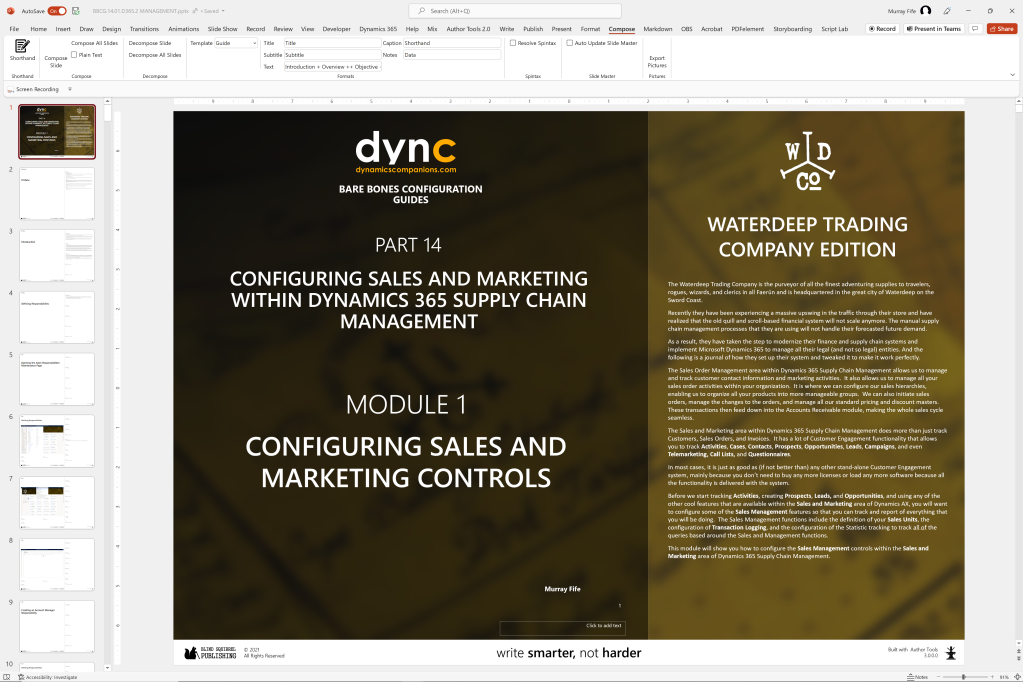
Debugging Electronic Reporting Models in Dynamics 365 Finance & Supply Chain Management
Introduction
If you have ever worked with the Electronic Reporting feature within Dynamics 365 Finance & Supply Chain Management, then you have probably spent a little bit of time trying to find out which are the right fields to bind within the data models. You have probably bound a field, thinking that it is the right one, only to find that the field is blank, and then all your electronic reports start failing.
I know how frustrating this can be, because I spent half a day trying to find where the customers email address was stored in the data model
Then I discovered that there is a handy feature within the Electronic Reporting, that allows you to Debug the data that is being returned by the Electronic Reporting, while you are running the reports.
As soon saw this, all my data hunting and pecking became a thing of the past.
In this quick do!torial, I will show you how to turn on the Electronic Reporting Debugging, and how it works.
Topics Covered
- Enabling Electronic Reporting Debugging
- Debugging Electronic Reporting
- Exploring the Data Model
Enabling Electronic Reporting Debugging
The first task that we need to do is to turn on the debugging feature for the Electronic Reports within Dynamics 365.
How to do it…
Step 1: Open the Electronic Reporting form
To turn on the Electronic Report debugging feature we will want to go to the Electronic Reporting workspace.
We can access the Electronic Reporting form through the main menu.
To do this, we will need to open the navigation pane, expand out the Modules and group, click on the Organization Administration group to see all the available menu items and then click on the Electronic Reporting menu item within the Workspaces group.

Step 2: Click the Reporting configuration tile
Then we will want to open the Reporting Configuration page.
To do this, all we need to do is click on the Reporting configuration tile.
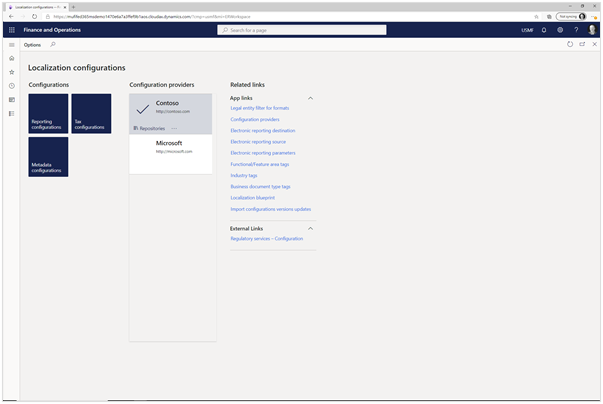
This will open the reporting configuration page for us where we will be able to see all of the different Electronic Report configurations and models.
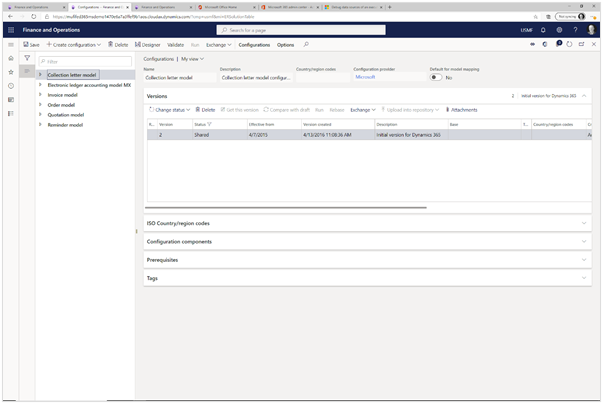
Step 3: Click the User parameters button in the Advanced settings group of the Configurations action pane
Now we will want to access the user parameters for the electronic reporting.
To do this, just click on the User parameters button within the Advanced settings group of the Configurations action pane tab.
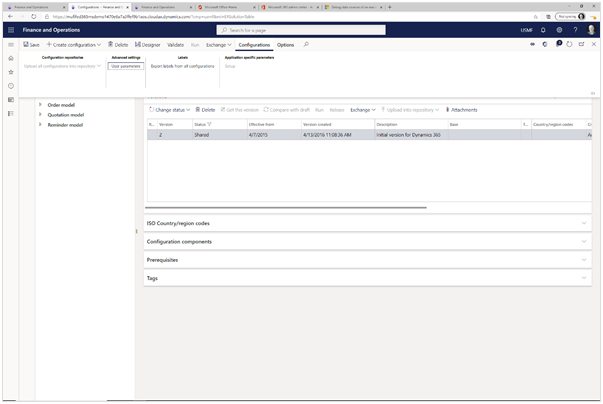
This will open the User parameters configuration panel, and we will see that there are a lot of different options that we can configure for Electronic Reporting.
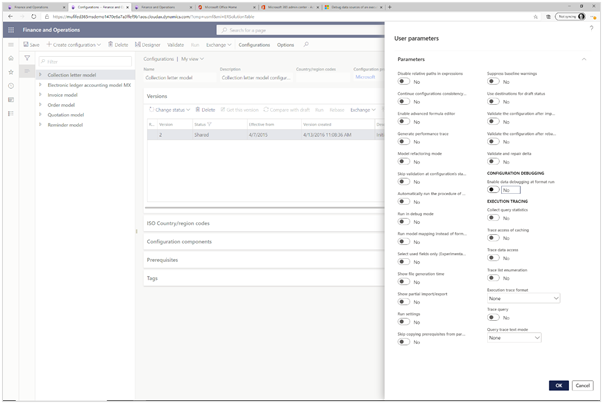
Step 4: Toggle the Enable data debugging at format run field and click the OK button
We are just interested in enabling the data debugging at format run.
To do this, we will need to toggle the Enable data debugging at format run option and click on the OK button.
This time, we will want to toggle Enable data debugging at format run to Yes .

Debugging Electronic Reporting
Now that we have enabled the debugging feature within Electronic reporting, we can now take a look at it in action.
How to do it…
Step 1: Click the Sales order record and click the Confirmation button in the Generate group of the Sell action pane
For this example, we will be debugging the sales order confirmation process. We have a Sales Confirmation Configurable Business Document configured within our system, and it is also configured to send the order confirmation to the customer, using the primary email address that is on the customer’s account.
We are having a problem finding the right email address field, so we will use the debugging feature to find it for us.
To do this, click on the Sales order record and click on the Confirmation button within the Generate group of the Sell action pane tab.
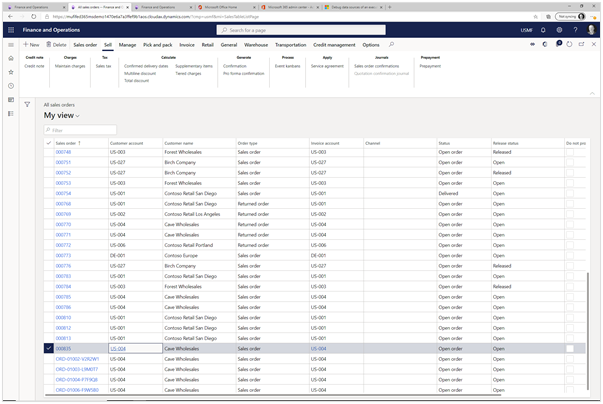
Step 2: Toggle the Print confirmation field, toggle the Use print management destination field and click the OK button
When the Confirm sales order dialog box is displayed, we will want to print the confirmation using the print management.
To do this, toggle the Print confirmation option, toggle the Use print management destination option and click on the OK button.
This time, we will want to toggle Print confirmation to Yes, toggle Use print management destination to Yes .
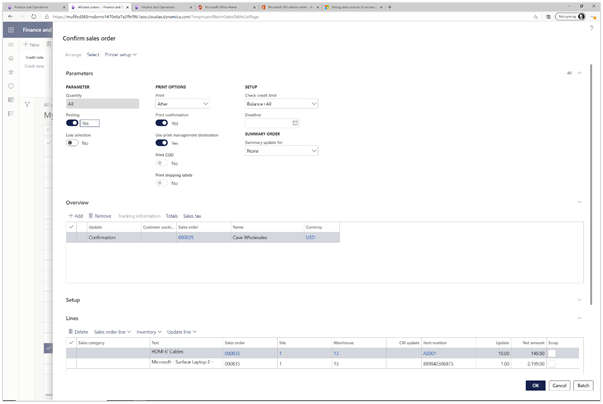
This will start the process of printing the Sales confirmation report.
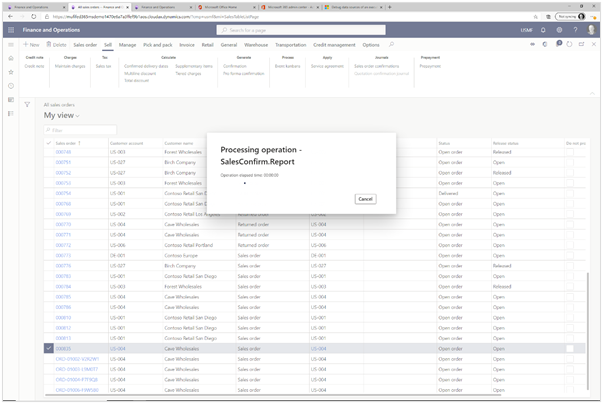
Step 3: Click the Yes button
Since we have the debugging enabled for the electronic reports turned on, we will not go straight to the report, we will be asked if we want to debug the electronic document.
Which we want to do.
To do this, just click on the Yes button.
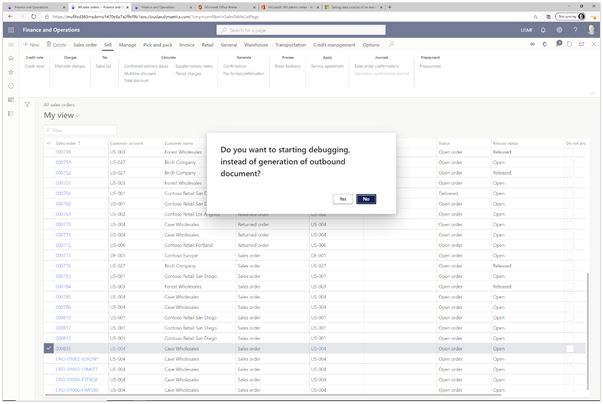
Now, rather than seeing the sales order confirmation report, we will be taken into the Debug Datasources explorer panel.
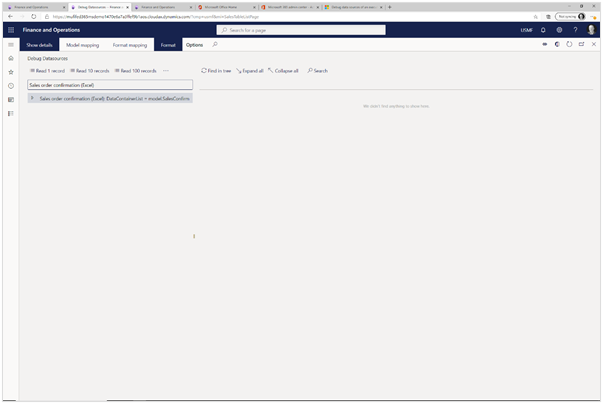
Exploring the Data Model
Now that we are in debug mode for the Electronic reporting, we can do a lot of different things, including browsing the data that is being returned from the data model, which is the data source for our Sales order confirmation.
How to do it…
Step 1: Click the Format mapping button
We will want to switch our view so that we can see the model mapping details.
To do this, just click on the Format mapping button.
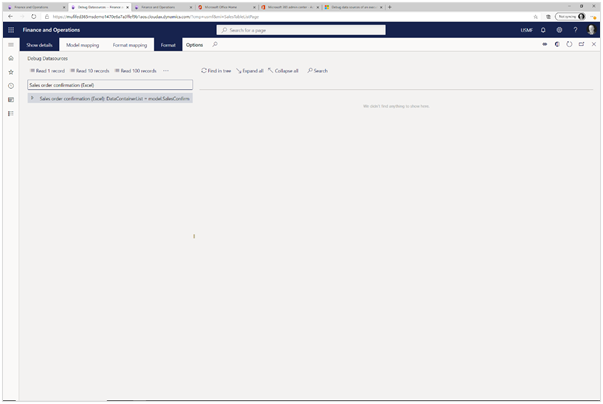
Step 2: Expand the model Record node
Let’s explore the data that we are working with.
To do this, all we need to do is expand the model Record node.

Step 3: Expand the SalesConfirm Record list node
Now that we can see that we are getting data back from the SalesConfirm record list, let’s see what fields are there.
To do this, just expand the SalesConfirm Record list node.
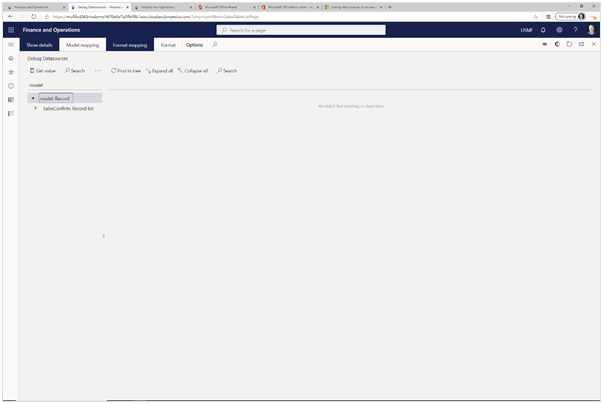
Step 4: Expand the Buyer customer party Record node
Now we will see all the fields that are mapped to the data source. Let’s drill further into the data source and look at the data that is in the customer party record.
To do this, just expand the Buyer customer party Record node.
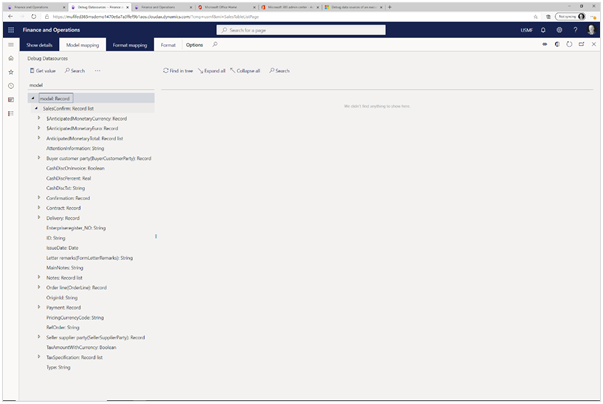
Step 5: Expand the Party Record node
Now we will drill into the party details.
To do this, all we need to do is expand the Party Record node.
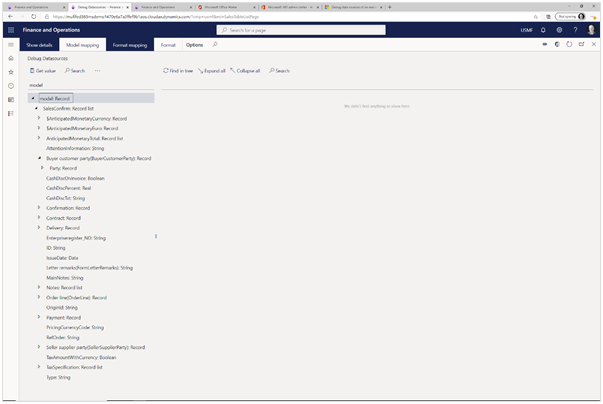
Step 6: Expand the Contact Record node
Now we are getting somewhere. We suspect that the email address is in the Contact record, so let’s drill in further.
To do this, expand the Contact Record node.
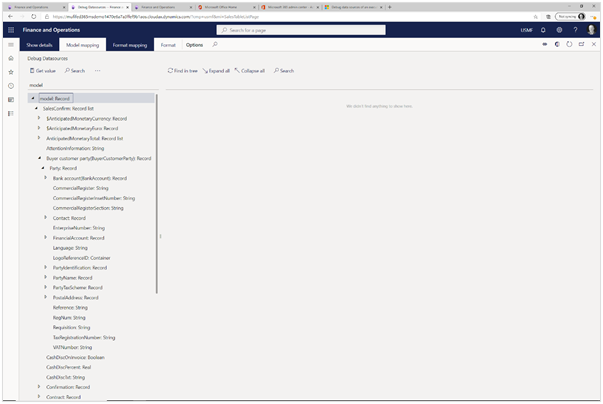
Step 7: Click the ElectronicMail String node
Under that node we can see that there is an ElectronicMail field that is probably where the email address is stored.
Let’s select that field.
To do this, just click on the ElectronicMail String node.

Step 8: Click the Get value button
Now we can get the value that is being passed through to the data model.
To do this, just click on the Get value button in the menu bar.

Step 9: Click the Expand all button
On the right hand panel we will now see that there is a Record model showing up. This is where we will be able to see the data that is linked to our data model.
To do this, just click on the Expand all button in the menu bar.
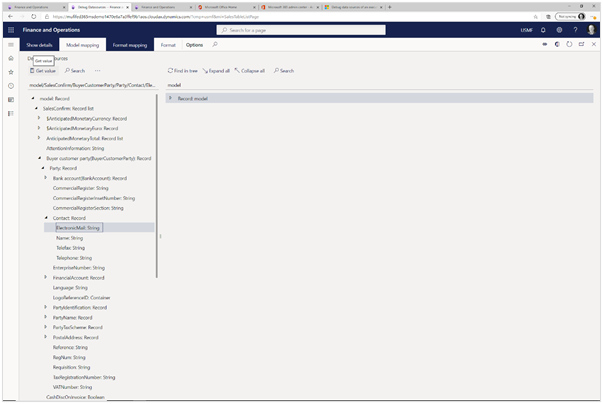
When we expand out the record model, we will see that the ElectronicMail field has a value, and that is what we are looking for.
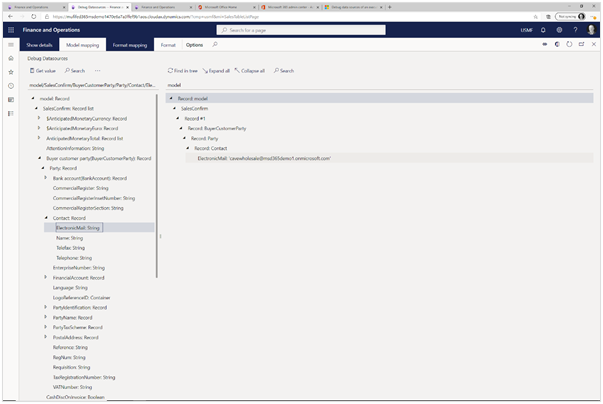
Review
How cool is that? Now we don’t have to guess what data is being returned through Electronic Reporting. We can use the debugging feature to wrangle our records and see where the data is within the data model.
This is a huge timesaver, and takes all of the guesswork out of linking data from the Electronic reporting models.
Configuring Social Media Information on Employees and Contacts
When you set up contacts within Dynamics 365 Finance & Supply Chain Management, you have probably set up their contact information, including their email address and their phone number.
Did you know though that you can also track the contacts social media contact details as well, such as their Facebook, Twitter and LinkedIn profiles as well, giving you a one-click link from their profile within Dynamics 365 over to their social media landing pages?
In this walkthrough we will show how you can configure the social media profiles against contact records through the Employee Self-service Portal, and how the contact details can be used to open the profiles within Twitter, Facebook, and LinkedIn.
Read More
Using Dynamics 365 Finance & Operations Business Events and Flow to send Forms Pro Surveys to Customers
This morning I got a notification that an order had been shipped, and it had a link to a survey. Which made me think – how hard is this to do in Dynamics 365?

I don’t know if many of you have played much with Forms Pro, but it is even better than Forms. I created a new survey, and just from the title of the survey, it pretty much built the entire set of satisfaction questions for me through the suggestions.
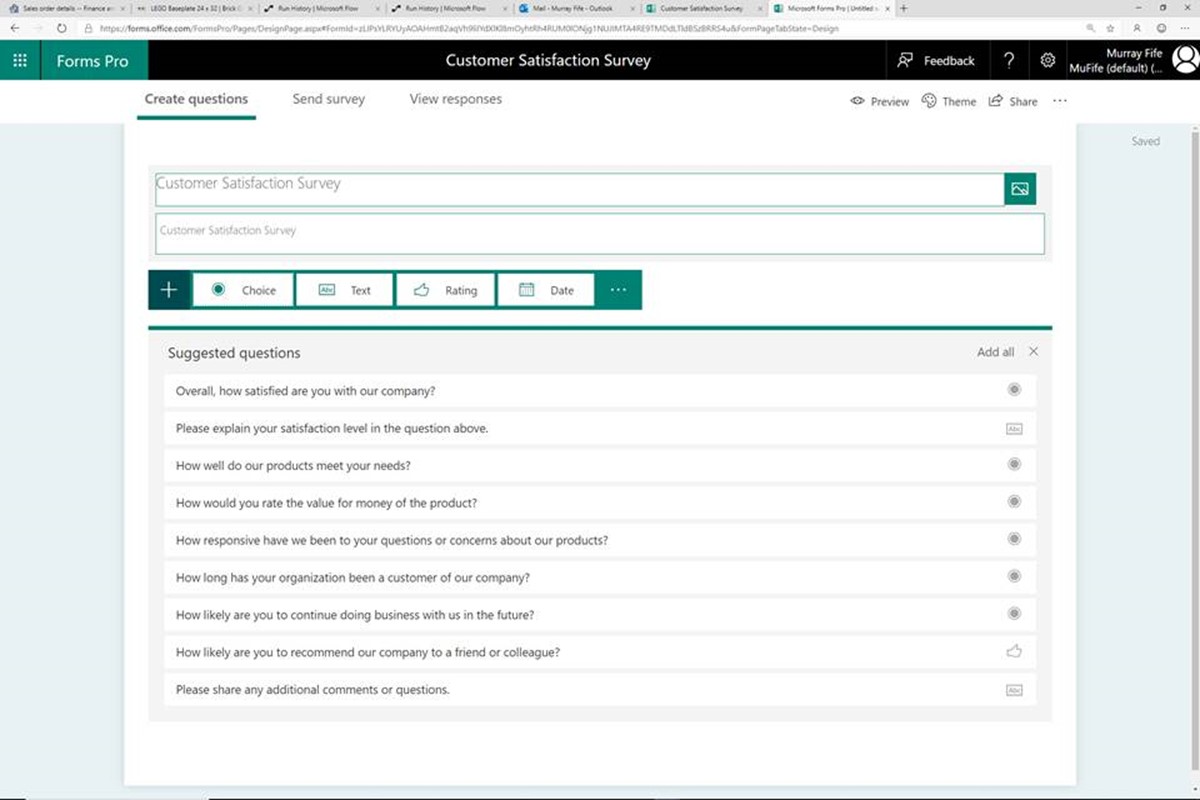
On the sales order, we are tracking the shipment, and when the product is shipped, the status is changed to Delivered.

So I attached an alert to the Status field to fire off a Business Event every time the order status is changed:
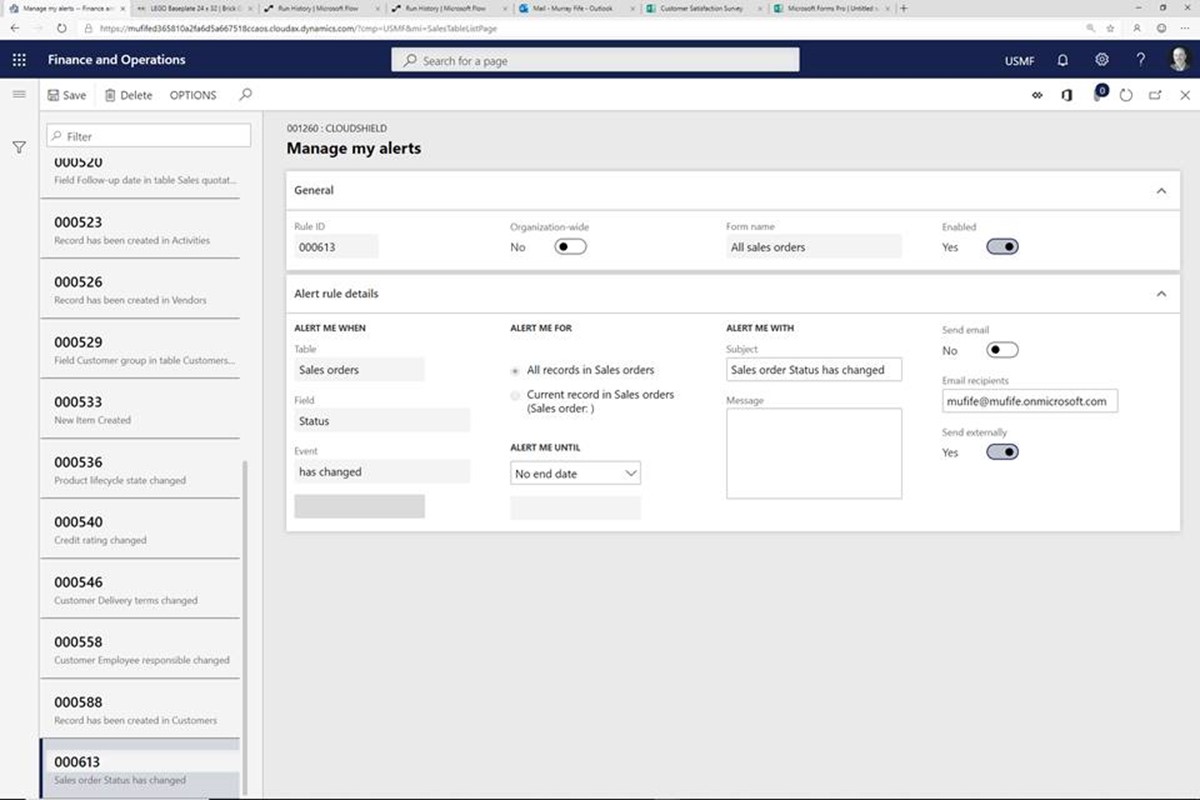
This lets me then use Flow to send out the survey to the customer email address that is registered on the order.
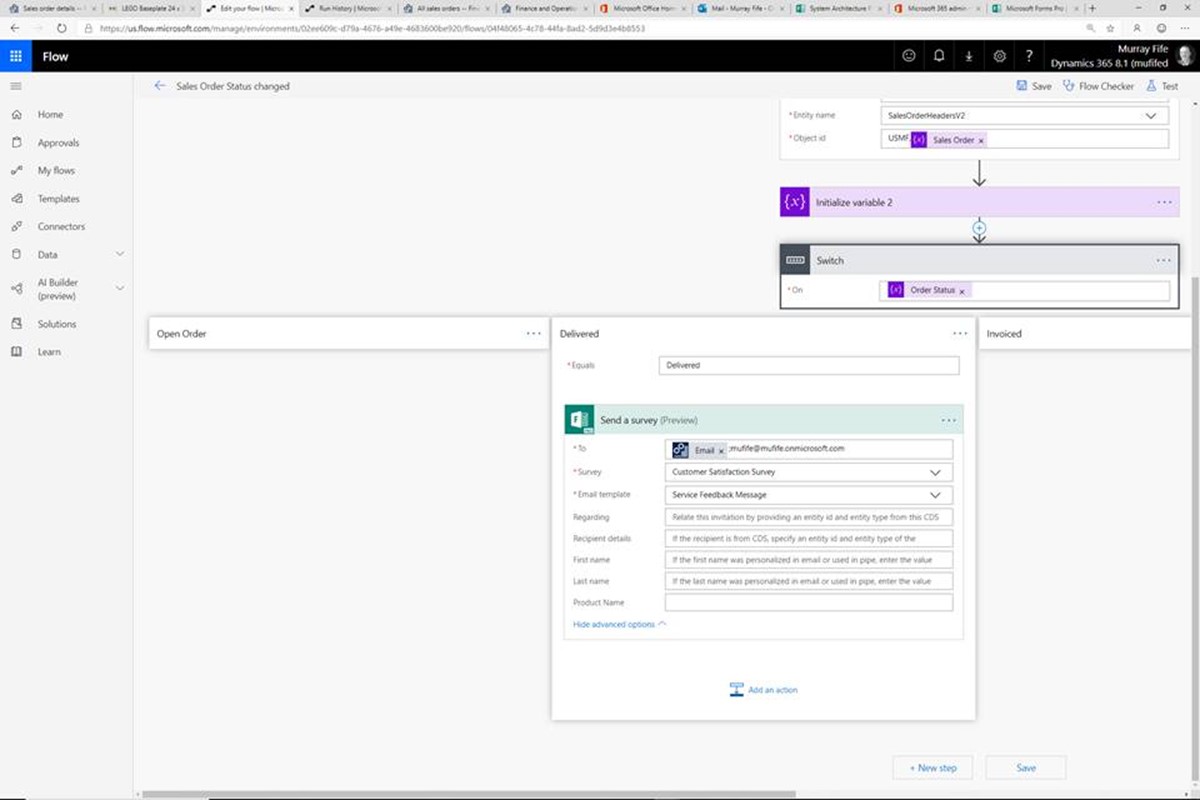
Just like a well oiled machine, within a couple of seconds of shipping the order through the F&O back office I got an email with a link to the survey:
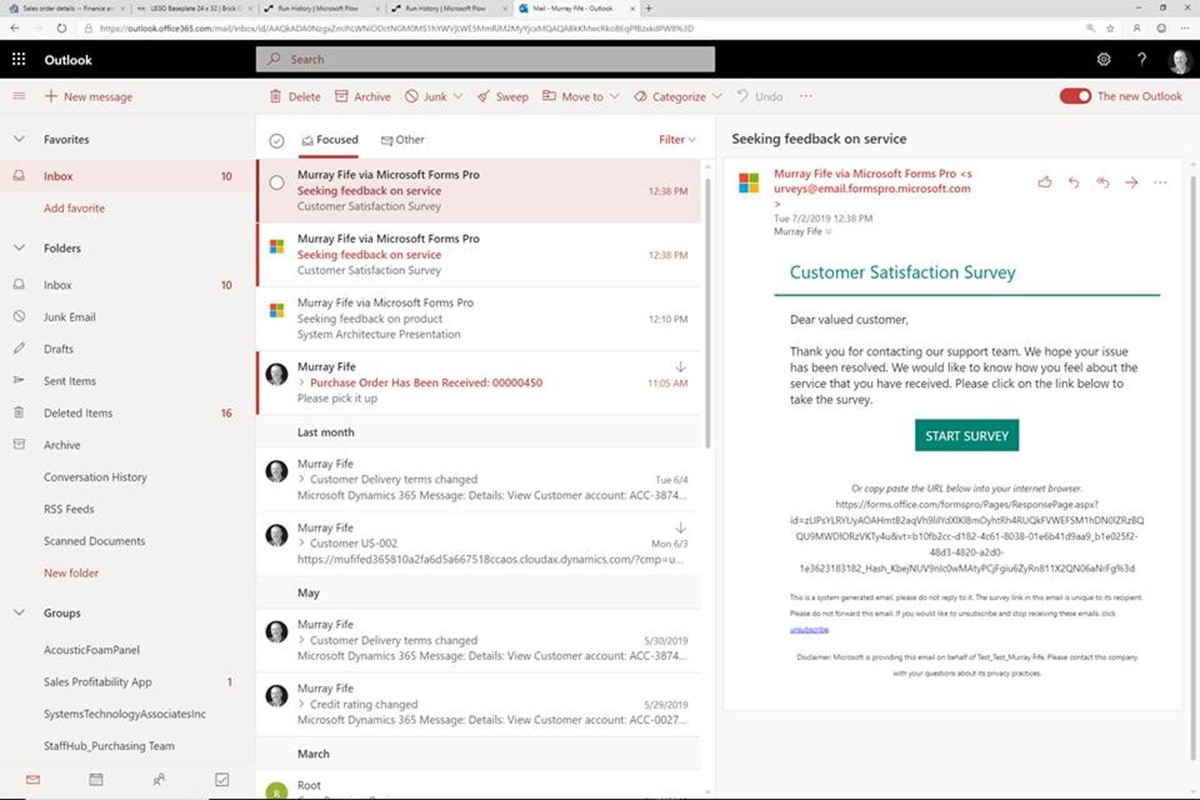
I was able to fill out the survey:

And I was starting to get analytics from the Survey within Forms Pro:
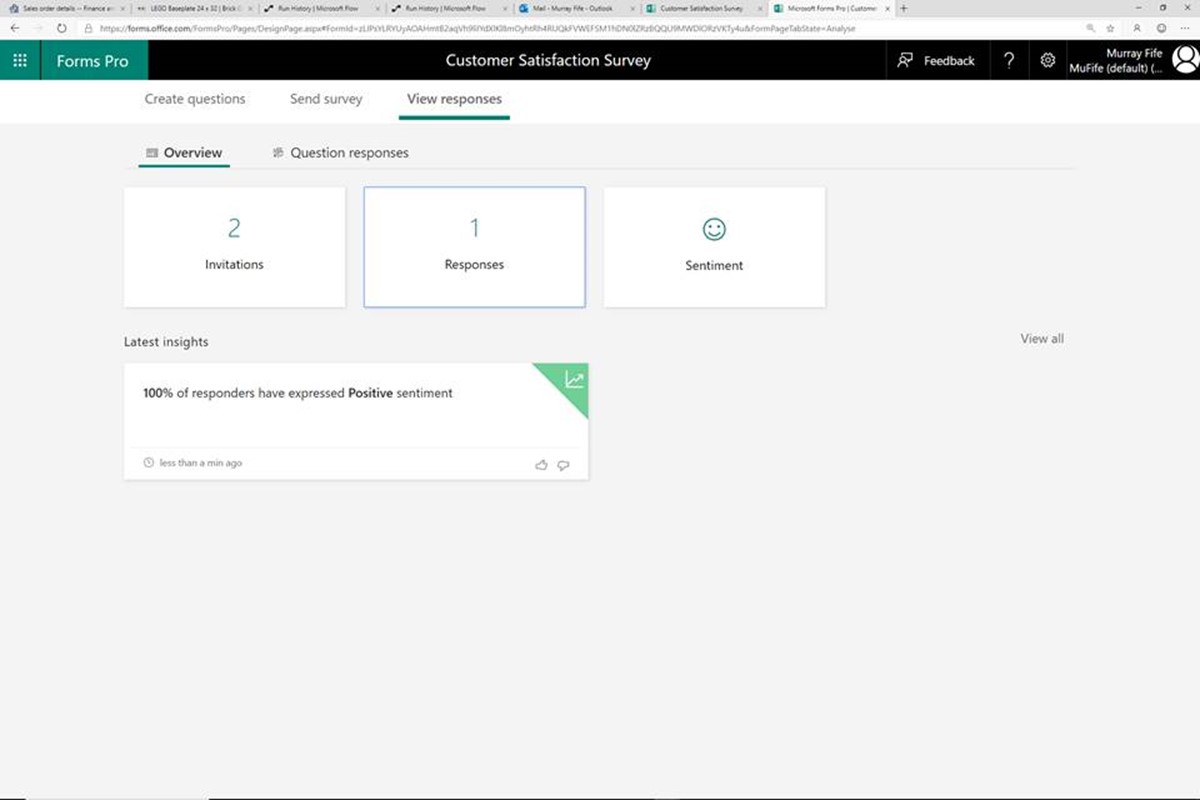
How cool is that? (Rhetorical question – this is cool as heck!)
Dynamics + Office rocks!
Using Cortana Calendar.help To Schedule Meetings
Scheduling meetings is a chore because you have to look at your calendar, select some times that are open, then create a meeting invite for one, or more meeting times to all of the attendees, then you have to track what time everyone wants to meet, rearrange schedules, re-send out meeting invites, remember to delete tentative meeting invites, and then hope that you got all of the responses from the people before you can have your meeting.
What a pain in the butt, and what a time suck.
Great news. There is a new Cortana service called Calendar.help that is available that allows you to get Cortana to do all of that work for you, find time that works in your calendar and then negotiates the time for you with all of the people that you want to meet with. And you can do that just by including Cortana in an email thread.
In this overview we will show you how to sign up for the Preview service and test it out.
Warning: This may make you never want to manually schedule a meeting ever again.
Topics Covered
- Signing up for Cortana Calendar Help
- Using Cortana Calendar Help to Schedule Meetings
You can now get the complete set of the
You can now get the complete set of the Waterdeep Trading Company Project at the bundled price through Dynamics Companions store, and start your own Advanced Dungeons and Dynamics implementation yourself. Premium members can download it for free.
You can now get the complete set of the
You can now get the complete set of the Bare Bones Configuration Guide for Configuring Cash and Bank Managenent within Dynamics 365 for Operations at the bundled price through Dynamics Companions store, and Premium members can download it for free.
You can now get the complete set of the
You can now get the complete set of the Bare Bones Configuration Guide for Configuring Accounts Receivable within Dynamics 365 for Operations at the bundled price through Dynamics Companions store, and Premium members can download it for free.